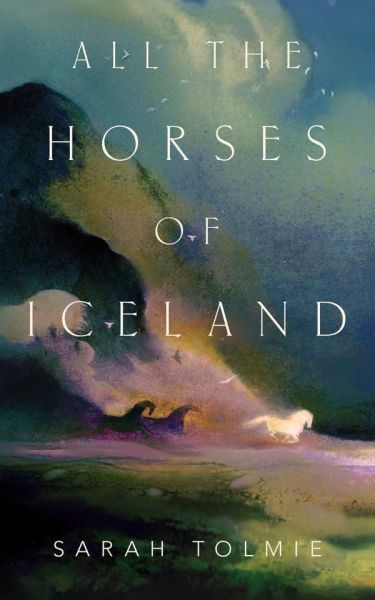A Horse With No Name
All the Horses of Iceland
By Sarah Tolmie

27 Jan, 2022
Sarah Tolmie’s 2022 All the Horses of Iceland is a historical fantasy.
The nameless horse’s 9th century1journey from Central Asia to Iceland began with religious conversion. More exactly, it began because a conversion was refused. Eyvind of Eyri, an Icelandic pagan and a sailor, finds Christian attempts to covert him unconvincing. When the captain of Eyvind’s ship converts to Christianity while docked in the Volga river trading community of Helmgard (modern Novgorod), only Eyvind refuses to follow the captain’s lead. Feeling out of place on the now Christian ship, Eyvind cashes in his shares and looks for other opportunities.
Eyvind hires on with Khazar merchant David. David wants to trade in horses. To obtain them, he must travel deep into Central Asia, across lands contested by the Khazars and Garthariki, the land of the Rus. Eyvind accompanies David. Which is how he becomes involved with a band of Khazar nomads.
Gan Sorqan Šira’s people have a problem. That problem is the gan’s late wife Bortë, whose restless ghost torments her people. Moving camp was futile. The ghost simply follows. Nor can Bortë’s mother Hoë’lün, a magician, dispatch her daughter’s shade. Hoë’lün suggests a solution: a foreign magician.
Eyvind does not count himself a sorcerer. He’s not interested in magic at all. But Hoë’lün is sure that he has all the signs of a possible magician and asks him for advice, which he gives without much thought. Advice is followed and Eyvind discovers that there are consequences.
Bortë no longer haunts the nomads. Now embodied as a white horse, she is fated to follow Eyvind. Whatever this will mean to Eyvind, it’s a win for the nomads, who no longer have to deal with the ghost.
Now the ghost is Eyvind’s problem.
~oOo~
As you no doubt have figured out, this novel spends a lot more time in Central Asia than it does in Iceland. But the novel’s account of Eyvind’s life after he returned home is touching and provides a satisfying coda to the plot. We also learn that Eyvind’s adventures will have important effects on 9th century Iceland’s future.
The Khazar Khaganate itself looked roughly like this:

Note that Kiev (Kyiv), from which Kievan Rus will take its name some years after this story, is within the Khaganate. Matters are not going well for the Khaganate, which casts a covetous eye on Eyvind’s horse (horses are necessary for defense). Matters continue to go badly for the realm2. Fans of the Khaganate may comfort themselves with the knowledge that Kievian Rus will get theirs in 1237.
I am not a big fan of historical fantasies because I stumble over “if magic is real, why was history the same?” See, for example, my interminable whining in reviews of Aliette de Bodard’s Paris novels. However, Horses of Iceland features supernatural horses of quite possibly dreadful consequence. Anyone of Celtic background will find this perfectly reasonable. It is a well-known fact that many horses are actually evil carnivorous water-monsters just waiting to drag the unwary to their doom. That’s just science. In this case, the horse is supernatural but it’s mostly mundane. Its particular gifts are neither those that would lead to the protagonist’s death nor derail history.
Le Guin (who blurbed Tolmie’s debut novel) would approve of this book. Rather than embrace modern vernacular for her historical fantasy, Tolmie uses formal prose to communicate that “this is not your 21st century.” She occasionally has to use vocabulary from later periods of this region (as explained in the afterword), but on the whole, readers will not be jolted out of the story by modern terms or modern slang3.
The stolid, pragmatic Eyvind is drawn first into a war zone and then into occult matters he would rather avoid. He’s an appealing character, just doing his best to get along without hurting anyone. Although the novel focuses on his adventures in Asia, the narrative of what followed his return home is just as delightful. The plot moves along handily and the prose is better than competent. An enjoyable book.
All the Horses of Iceland is available here (Amazon US), here (Amazon Canada), here (Amazon UK), here (Barnes & Noble), here (Book Depository), and here (Chapters-Indigo).
1: There’s some textual evidence — a reference to Greenland — that appears to place the narrative a century later than it is set. I asked the author about this and was told that while Eric the Red’s settlement was the first documented, that does not mean there were not earlier now-undocumented forays into Greenland. Also, the Oleg and Olga of Helmgard are not meant to refer to historical figures. Garthariki’s name pool is just as limited as that of 19thcentury’s Canada political elite.
2: About a thousand years later and a few hundred miles to the East, the descendants of the Rus will trouble the characters of A Bride’s Tale. “The Rus are a giant pain in the ass” is something of an ongoing theme for the region. Too bad for Eyvind he looks a lot more like a Rus than he does a Khazar.
3: However, there is a reference to what is very clearly the Laki eruption, which, centuries later, will kill about a quarter of the human population of Iceland.
